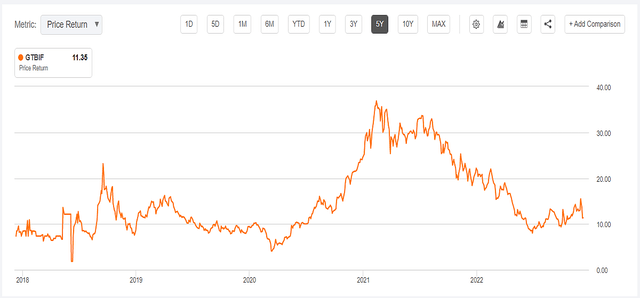ArtistGNDphotography
Cannabis investors have been ravaged and buffeted, subjected to dashed dreams and unrequited love for much of the time they have been active in the sector. Many are questioning themselves and tired of the emotional roller coaster. My message is, “Don’t worry, anxiety doesn’t have to be part of investing in cannabis.” I don’t worry about cannabis, and you don’t need to either.
Essentials for worry-free cannabis investing
Worry-free doesn’t mean one can sit back and do nothing. Freedom from anxiety and worry is subject to certain conditions, all of which are under your control. It is not dependent on what is happening in the sector. Success in eliminating worry and anxiety is directly proportional to how well you follow five imperatives:
-
Apply the lessons of history.
-
Think long term.
-
Think independently.
-
Be conservative.
-
Avoid hopium.
Lessons of history
Cannabis is one of the great social movements of our time. We can learn much about the future of cannabis by studying the path of other significant social changes, such as civil rights, gay rights, alcohol, and gambling. While these movements are different in many ways, there are important commonalities in the way they progressed. All took many years of struggle, with strong opposition on mostly moral or social grounds, gradually gaining public support, culminating in rapid legitimization into the mainstream. Cannabis is taking the same path. Clearly we are past the point of minority advocacy and now in a phase of mainstream acceptance. The final stage is official legalization. As with the other social movements, momentum is unstoppable, and the only question is how long before it reaches the same status as drinking, playing the lottery, gay couples marrying, and so on.
Taking gambling as an example, according to Wikipedia, before the American Revolution there were 392 local lotteries in the 13 colonies. After the Revolution, all 13 states started lotteries to raise revenue. But by the 1830s reformers were denouncing lotteries on moral grounds, by 1860 they were gone from all but three states, and by the 1890s federal laws brought in effect complete “prohibition.” It stayed this way until 1964, when New Hampshire instituted the first modern state lottery. Other states, seeing the easy money, quickly started their own, and today this formerly immoral activity is legal in 45 states.
State expansion of cannabis has continued apace in 2022, and there has been more positive movement in cannabis on the federal level in the last year than in the previous 52 years since the Controlled Substances Act in 1970. This year has seen Biden’s order for expungement for simple possession, his order for a rescheduling study, passing the cannabis research act, and SAFE Banking inching closer to Congressional passage. Some people discount the progress by saying that some haven’t been made into law, like SAFE Banking or descheduling. Social change is an incremental process. You keep knocking on the door until eventually you are let in.
Think long term
From the time I began covering the cannabis sector I have said it is a long-term investment, highlighting this position in articles like My 5-Year Cannabis Investing Plan and Message From Cannabis: It’s Going To Be A Longer, Harder Trek. This is still the case and will continue to be. Global growth of cannabis is still in its early stages, but the long-term potential is undeniable. According to one recent research report, the $25 billion 2022 market will grow at a CAGR of 27% to $87 billion in 2027.
Emphasis on the long term means not being influenced by short-term price moves, sentiment, or market conditions. While we need to be aware of current developments, 90% (at least!) of what appears in the news is irrelevant and a distraction. Most people understand this but find it difficult to put it into practice. We see the dangers of being caught in short-term thinking in the recent SAFE Banking saga. AdvisorShares Pure US Cannabis ETF (MSOS) was around $9 per share in October, but many investors bought at higher prices in the last two months at prices as high as $14.33. Now the shares are at $10.05, putting some shareholders in a deeper hole than necessary.
Think independently
Much recent conversation is about how poorly cannabis stocks have done since their peak in February 2021. There are lessons to be taken from that, and it has certainly been traumatizing for some individuals, this view is not helpful. We are not in 2021 and are about to enter 2023. Investors buy companies, not sectors. Thinking about 2021 is a distraction from what is happening now. As an example, look at the five year chart for Green Thumb Industries (OTCQX:GTBIF).
Focusing on the price since 2021 suggests a company in severe decline. However, since July the shares are in a distinct uptrend. It’s also worth noting that the shares are 54% higher than five years ago.
Green Thumb 5 year chart (Seeking Alpha)
There’s no point in continuing to mourn our cannabis losses. We need to learn from our mistakes, regroup, look at where things are now, and move forward on that basis. A good place to start is by recognizing that industry conditions are very different than just a few years ago, that conditions are always changing, and that they will inevitably be very different several years from now. Over time, an industry growing at a 27% CAGR will inevitably contain strong companies, strong profits, and industry conditions significantly better than today’s very trying bear market.
Be conservative
I am a conservative investor. My portfolio is loaded with large, income producing stocks like AbbVie (ABBV), Enterprise Products Partners (EPD), Philip Morris (PM), and Exxon Mobil (XOM). By taking the long-term view, I can view cannabis as a conservative investment. As referenced above, big growth by cannabis around the globe is inevitable. Also inevitable are successful, large companies that will mint big profits for themselves and their investors.
Being conservative in cannabis means not investing money you can’t afford to lose. No one should be dependent on cannabis stock prices for emergency money, education expenses, down payment on a living space, or other critical needs.
Being conservative means investing in the financially strongest, best capitalized companies. A Curaleaf (OTCPK:CURLF), Canopy Growth (CGC), Green Thumb or Trulieve (OTCQX:TCNNF) is much better prepared to outlast negative industry conditions than a company with excessive debt like Ayr Wellness (OTCQX:AYRWF), or companies with consistently negative cash flow like Ascend Wellness (OTCQX:AAWH).
Being conservative means investing in the best run companies. This means paying attention to financial indicators of good management like the interest/income ratio, net income, and cash flow. I highlighted the importance of cash flow in Green Thumb: Undisputed Cash Flow Champion In Cannabis, in which Curaleaf, Trulieve and Verano (OTCQX:VRNOF) were at the top along with Green Thumb.
Being conservative means considering ETFs. An ETF investment eliminates the risk of total loss. It is also suitable for newer investors and those who do not wish to put in the many hours of research necessary to navigate this sector, because of either knowledge or inclination.
There is still a place for smaller companies for the conservative investor. One approach is to identify companies that may have a special characteristic or approach to cannabis. Some examples I have written about are Schwazze (OTCQX:SHWZ) and InterCure (INCR). These companies require close attention and a willingness to sell if it becomes evident their approach won’t work out.
Avoid hopium
Hopium is the idea that somehow a company will do well or turn around without tangible signs that it is able to do so. After hope is gone, hopium takes its place, and it’s most often fatal. On the other side is confidence, when hope is backed up by evidence of pending success.
A prime example of hopium is California, where it seems to be the primary investment thesis. Medical cannabis has been legal since 1996, adult use since 2018. Yet it is still the most difficult place in the country to have a profitable legal operation. The problems there are well known, persistent, and pervasive. The black and grey markets are not going away, and the legislative and regulatory regimes do not seem to have the ability to turn things around. Many would agree with Sgt. James Roy of the Riverside County Sheriff’s Department, quoted as saying that “The illegal industry is competing with the legal industry and essentially putting them out of business.” And according to the Reason Foundation, “the effective tax rate on marijuana in California ranges from $42 to $92 per ounce, depending on the jurisdiction, compared to an estimated wholesale production cost of $35 per ounce.” Yet investors are still attracted to TPCO (OTCQX:GRAMF), Glass House Brands (OTC:GLASF), and others, with only the vague idea that one might surmount the problems that have prevented any profits from being generated in the state.
The merger of Cresco (OTCQX:CRLBF) and Columbia Care (OTCQX:CCHWF) may also be hopium. At the time of the merger announcement, there was little clarity about what the combined company would be after dispositions, de-duplication and integration, and the prevailing feeling was that somehow after numerous major changes the result would be okay. On top of that was the idea that combining two large unprofitable operations would somehow create a large profitable one, although there are few or no documented instances of that happening in the sector. We’ll see.
In contrast, Schwazze is an example of hope instead of hopium. The Schwazze plan is to consolidate and out-execute competitors in Colorado, where legal cannabis is well-established, and eventually sell the company for a profit. Schwazze leadership successfully executed a similar plan with the Albertsons grocery chain, and they have been beating the performance of Colorado competitors. Thus there are tangible reasons for confidence in the company’s future.
Summing up
Investing involves uncertainty and loss, with a host of emotional responses. Investing in emerging growth, with its small companies, high volatility, and no track record, intensifies those responses. We can’t control markets, economies, or stock prices. We can’t eliminate risk and uncertainty when investing in stocks. What we can control is how we respond to these things. We can let ourselves be mentally buffeted by outside events, or we can foster ways of thinking that encourage clarity, objectivity, and stability. When it comes to cannabis, part of this process is training ourselves to think in the ways outlined in this article:
-
Remember the lessons of history
-
Think long term
-
Think independently
-
Be conservative
-
Avoid hopium
Working on these will take the anxiety out of cannabis investing, bring back the joy, and by the way improve results. There are people who like a riskier, high intensity, high excitement approach, and to those people I say, “Go for it!” They have their own set of reasons for investing. But the approach advocated here is suited to the needs of the majority of investors, like me, whose overarching goal is building wealth over time.


Be the first to comment